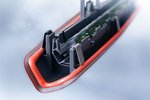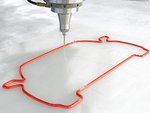
FIPFG and FIPG are on the fast track
The success of liquid sealants in automotive and vehicle construction continues. Thanks to high-performance materials as well as innovative manufacturing and assembly processes, in-situ sealants (Formed In Place Gaskets (FIPG) / Formed In Place Foam Gaskets (FIPFG)) are being used in an increasing number of applications with diverse requirements and sealing geometries.
Door and door lock modules, loudspeakers, airbag, air conditioning and glove compartment covers, brake lights, headlights, combination rear lights, electrical enclosures, ignition coil covers, fuse boxes, ventilation grilles, and water boxes – All of the above mentioned are protected reliably and durably against moisture, water, dust, and chemical influences by FIPFG or FIPG made of polyurethane (RAKU® PUR) or silicone (RAKU® SIL).
Depending on the chemical, physical, and mechanical requirements, four different sealing systems are used:

Liquid sealing foams
are applied in grooves and forms and are self-levelling. Both tolerances of <0.3 mm and sealants with a cross-section >= 2.5 mm can be achieved. Applications: Liquid sealants are frequently used in the LED and lighting industry. RAMPF offers a variety of liquid systems with different properties, including antibacterial, UV-stable, and flame retardant.

Thixotropic sealing foams
are the most frequently used systems in automotive engineering. They are applied to surfaces of three-dimensional components or with a flat groove in a height-to-width ratio of 1:2 to 1:1. Applications: Thixotropic sealing foams are used, amongst others, in the automotive industry. For example, RAMPF’s PU gasket RAKU® PUR Speed is used for sealing door modules and tail lights. Due to its extremely short curing time, the processing of components can be continued shortly after application.

Compact seals
based on polyurethane and silicone are produced by polymerization without volume changes and can be adjusted from liquid to pasty. Characteristics include a wide hardness range, very high mechanical strength, and high elasticity of up to 500 percent (e.g. RAKU® SIL 37-1001). In addition, the gaskets score with very good vibration and sound absorption (NHV) as well as high pressure resistance. Applications: Compact seals are used, amongst others, in the automotive industry (e.g. temperature control systems, battery housings).

Moulded foamed gaskets
are inserted into the given mould or groove via a 2-component mixing and dispensing system. After the foam has been applied, the component is placed. The foam expands, rises upwards, and bonds with the component. After a very short time, the foam is able to be demoulded and the component can be removed. All geometries are possible, regardless of height-width ratio. Applications: Moulded foamed gaskets are used, amongst others, in the engine compartment and inside of the vehicle interior (e.g. air conditioning system, partition walls).
The advantages of FIPFG / FIPG Gaskets
In comparison to inlaid or directly bonded sealants, FIPFG / FIPG are applied via mixing and dispensing systems and develop adhesion without the use of additional adhesive tape.
The sealing systems adapt to the component in an optimal way and lie stress-free in the groove.
The chemical properties are tailored specifically to the respective requirements.
The automatic application of the liquid gasket without coupling points and bonding ensures reliable and long-term tightness, as the non-separable gasket is firmly attached to the component.
Economic advantages include accelerated and simplified manufacturing and assembly processes. Furthermore, there are no extra tooling costs and the use of NC technology enables the flexible adjustment to a change of components.
FIPFG / FIPG also offer a high degree of flexibility, as the gaskets are adapted exactly to the products and the process conditions of the customer. The number of components as well as warehouse stock can be reduced. Color, shape, and geometry can be designed at will.
Outlook
In the automotive industry, both the areas of application and the demands on the performance of FIPFG and FIPG systems will continue to grow. Due to increasing connectivity and the development towards autonomous vehicles, vehicle interiors in particular are becoming more important.
Here, sealants have to perform under increasingly complex structures. The additional requirements of the industry for low-emission, sustainable, and weight-optimized systems also affect the sealing industry.
 PerfectionPerfect fit, perfect seal: liquid seals are applied automatically without coupling points or adhesion and are firmly bonded to the component.
PerfectionPerfect fit, perfect seal: liquid seals are applied automatically without coupling points or adhesion and are firmly bonded to the component. Seals in the interiorNoise and odors undesirable: in-situ seals are omnipresent in vehicle interiors.
Seals in the interiorNoise and odors undesirable: in-situ seals are omnipresent in vehicle interiors. Fully automatedOptimum interaction between material and machine: Ultra-fast, fully automated application processes are standard in the automotive industry.
Fully automatedOptimum interaction between material and machine: Ultra-fast, fully automated application processes are standard in the automotive industry. In-situ sealsIn-situ seals efficiently and reliably seal a wide variety of components in automotive and vehicle construction and thus contribute to a safe journey.
In-situ sealsIn-situ seals efficiently and reliably seal a wide variety of components in automotive and vehicle construction and thus contribute to a safe journey.
